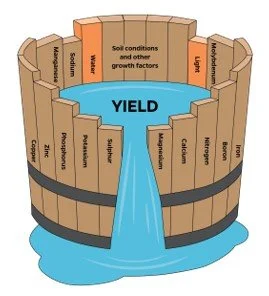Investing In Increasing Wheat Grain Protein - Is It Worth It?
Many growers want to push grain protein higher in order to capitalize on protein premium incentives. When it comes to protein content in spring wheat it is important to consider the interactions of management, genetics, and environment. But ultimately, there is very little that can be done at the farm level to influence grain protein content and here’s why:
Management influence
Research has proven that compared to spring fertilizer application; split nitrogen fertilizer applications will increase grain protein content (IF there is a rain following the application). To see this theory for ourselves, in 2022 Pitura Seed Farms performed a Top-Dressing UAN trial in one of our spring wheat fields:
The backstory: 2021 was a dry growing season which resulted in high residual Nitrogen in the fields. Spring 2022 was a wet spring and we saw significant leaching of nitrate-N into the subsoil and root development was shallow in the soil profile. Because of these conditions, Pitura Seed Farms decided to top dress UAN at the early boot stage to ensure there was enough N in the root zone for yield development. Plus, there was a good chance of rain for the day after application to wash the fertilizer into the root zone – this is key for the success of this trial. Note that the goal of this trial was for yield increase not protein. Application for protein development would’ve been applied at a later stage prior to grain fill.
Main take-away: The treatment of 40 lbs/ac top dresses N was the only treatment we saw return on investment but this is due to the increase in bushels produced. You will see a quicker return on investment by focusing on increasing volume per acre rather than chasing higher protein through fertilizer management.
Genetics influence
During variety development, one of the considerations for moving forward with a line is the protein-yield potential. Ultimately, high protein grain is an important part of our food system – providing high nutrition per unit of food to the population. There have been significant advancements in the protein potential of our spring wheat varieties over the last few generations.
Through genetic mapping of spring wheat, there was a gene discovered (GPC-B1, GPC = Grain Protein Content B1) that is known as “the protein gene”. It is a gene that can increase % protein in the grain by shortening of grain-fill period of the plant. A shorter grain-fill period allows for less dilution of the protein in the kernel with starch and results in higher % protein in the grain. In our current varieties, the GPC-B1 gene in present but rarely functional. Even when the GPC-B1 gene is functional, its effects are highly influenced by the environment and crop management, especially during flowering and grain-fill.
At the end of the day, even after choosing a variety with strong protein potential and adjusting the fertility management to promote protein development, weather trumps all when it comes to the influence on grain protein content.
The Big one: Environment influence
High Yield = Low Protein. We see consistently that yield and protein are oppositely correlated.
In wet years, yield potential increases because the plant will use all of the available N to produce more starch/yield (= plump kernels). Additional nitrogen would be required to increase protein content in the kernel – this is where we hit an economic threshold of N application. The cost of additional fertilizer isn’t often covered by the premium that the increase in protein would receive without additional yield.
In dry seasons, the crop yield is less likely to respond to additional nitrogen applications because N availability is not the most limiting factor to the wheat crop. Think of the “leaky barrel” or Liebig’s Law of Minimum – The loss of yield potential is based on whichever panel is the shortest/in short supply. So, in dry seasons, the crop yield is limited by water availability and the N that the wheat crop takes in is often allocated to grain protein rather than starch/yield development. This is why we often see low yield = high protein.
Chart 1 and 2: Percent of Normal Growing Season Precipitation compared to Pitura Seed Farms Spring Wheat Yield (bu/ac) and Grain Protein over 4 years.
In conclusion, focusing on influencing grain protein yield will rarely provide you with a return on investment. Choosing wheat varieties with high yield potential and strong protein potential will set you up for success but the key thing to remember is the overriding factor affecting protein in wheat is weather during the growing season.
~Katie Meggison



